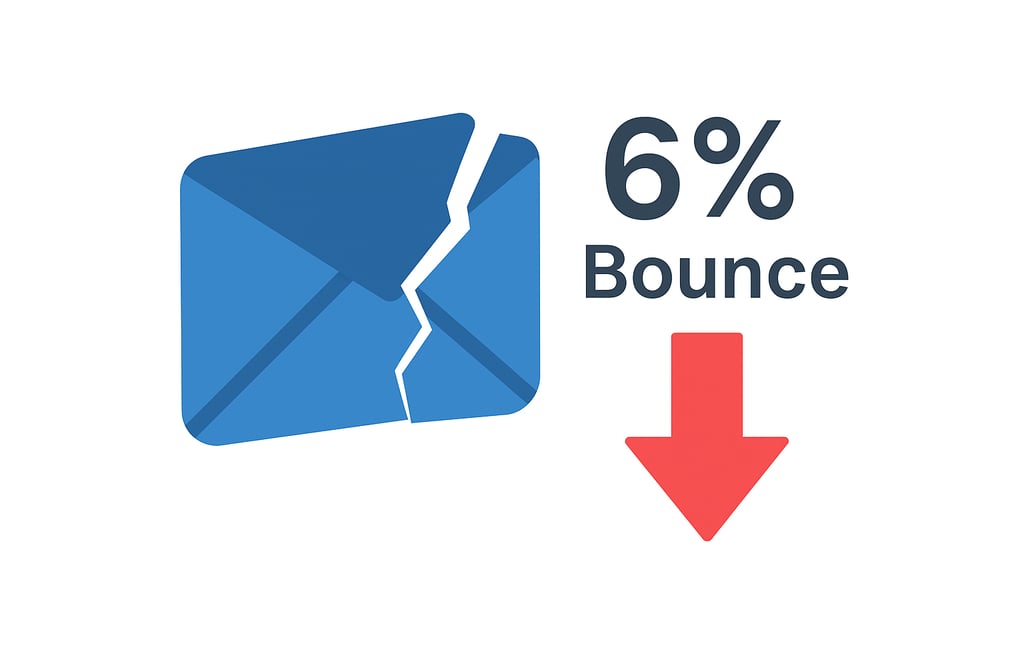Why Email Bounces Kill Cold Campaigns (and How to Fix Them)
High bounce rates can wreck your cold email results. Learn what causes them and how to keep your sender reputation safe using verified B2B data.
B2B LEAD GENERATIONDATA VALIDATION & ACCURACYNEVERBOUNCECOLD CAMPAIGNS
CapLeads Team
10/16/20252 min read


Why Email Bounces Kill Your Cold Campaigns (and How to Prevent Them)
When it comes to cold outreach, one hidden metric can quietly destroy your campaign from the inside — your bounce rate.
If more than 5% of your emails bounce, you’re not just losing delivery; you’re damaging your entire outreach infrastructure — from your mailboxes to your domain reputation.
Let’s break down what really happens when your bounce rate climbs too high, and what you can do to fix it before it’s too late.
1. Your Mailboxes Get Flagged
Each email you send leaves a reputation trail. When ISPs (like Google or Outlook) detect too many undelivered messages from your address, they flag your mailbox as “risky.”
At first, it’s subtle — you’ll notice fewer opens, fewer replies, and more messages landing in spam. But once that reputation score drops, every future campaign you send from that mailbox becomes harder to deliver.
Even if you later fix your data, your mailbox still carries that history.
2. Your Domain Reputation Takes the Hit
Your domain reputation works like a credit score for email sending.
Once your domain is linked to poor deliverability (from consistent bounces, spam complaints, or bad engagement), it affects every mailbox tied to it.
That means even if you switch sending tools or create new inboxes, the problem follows your domain name.
Recovering can take weeks or months — and in extreme cases, you might need to buy a new domain to start fresh.
3. Your Campaign Performance Collapses
A high bounce rate triggers automatic filters that push your entire campaign’s inbox rate down.
Your messages may look fine in testing but get silently routed to spam folders in real sends.
Once that happens, your metrics spiral — fewer opens, fewer clicks, and fewer conversions. Essentially, you’re spending time and money sending to an audience that never even sees your message.
Common Causes of High Bounce Rates
Outdated or purchased lists – many addresses are invalid or abandoned.
No prior validation – unverified emails that fail at send time.
Sending too fast from new domains – warming periods ignored.
No SPF, DKIM, or DMARC setup – lack of authentication lowers trust.
Typos and formatting errors – human errors that go unchecked.
Even a small mistake repeated across thousands of sends can kill your domain’s credibility overnight.
How to Keep Your Bounce Rate Below 2%
✅ Use validated data only – Run every list through a trusted validator before sending.
✅ Warm up slowly – Increase volume gradually when using new mailboxes or domains.
✅ Set up proper authentication – Configure SPF, DKIM, and DMARC to verify legitimacy.
✅ Clean lists regularly – B2B contacts change jobs fast; re-validate before every campaign.
✅ Monitor bounces daily – Anything above 3% is a red flag.
The Takeaway: Clean Data Wins
Cold email isn’t just about sending — it’s about delivering.
Once your bounce rate hits 5%, the damage compounds: mailboxes lose trust, domains get flagged, and campaigns stop producing results.
That’s why the smartest outbound teams don’t gamble on data. They start clean.
At CapLeads, every dataset is NeverBounce-validated and verified with direct phone numbers and C-level decision-makers — so your campaigns reach real inboxes, not error messages.
👉 Start your next campaign with verified B2B leads that actually deliver.
Related Posts
FinTech B2B Leads in 2025: Verified, Updated, and Ready for Outreach
Why Email Bounces Kill Your Cold Campaigns (and How to Prevent Them)
Why Startups Struggle to Find Quality Leads (and How to Finally Fix It
SaaS: The Hidden Growth Multiplier for Founders Using Verified Outreach Lists
The New Era of Smart B2B Prospecting
Cheap Leads Cost More: How Junk Data Destroys Early-Stage Growth
Inside the Data Lab: Lessons From Cleaning 150,000 B2B Leads (and Counting)
We Validated 30,000 B2B Leads — 30% Were Fake. Here’s What We Found.
Connect
Get verified leads that drive real results for your business today.
www.capleads.org
© 2025. All rights reserved.
Serving clients worldwide.
CapLeads provides verified B2B datasets with accurate contacts and direct phone numbers. Our data helps startups and sales teams reach C-level executives in FinTech, SaaS, Consulting, and other industries.
